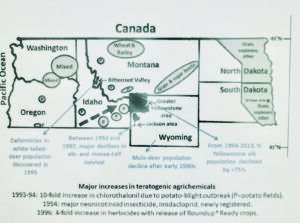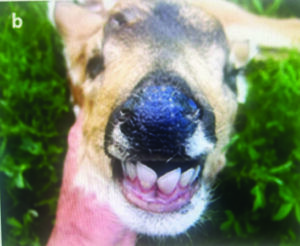
by Michael Howell
A recent article linking population declines in multiple ruminant species in Montana and surrounding states from 1995-2013 to the use of pesticides was published last month in the peer reviewed scientific magazine Chemosphere (Vol. 359). Authored by local scientist, biologist, naturalist and wildlife rehabilitator Judy Hoy of Stevensville, local biologist and taxidermist Gary Haas of Big Sky Beetle Works in Florence, and Dr. Pamela Hallock, a researcher and professor at the University of South Florida, the article addresses the question: “Was the massive increase in use of teratogenic agrichemicals in western states (USA) associated with declines in wild ruminant populations between 1994 and 2013?”
The article reviews a large number of studies documenting population declines in multiple ruminant species in Montana and surrounding states starting in 1995 as well as studies documenting the massive increase regionally in 1994-1996 in the use of teratogenic agrichemicals, notably neonicotinoid insecticides, fungicides, and glyphosate-based herbicides including published and new data on underdeveloped facial bones in regional ruminants; published and new data on reproductive abnormalities in live and necropsied animals before and after 1994; and studies documenting the effects of exposures to three of the most applied teratogenic chemicals.
 “While answers to the question posed above are complex and insufficient evidence is available for definitive answers, our goals are to provide ideas for further consideration and study,” according to the authors.
“While answers to the question posed above are complex and insufficient evidence is available for definitive answers, our goals are to provide ideas for further consideration and study,” according to the authors.
Hoy and her husband first noticed a decline in the local deer population in 1995, accompanied by an unusual number of deer with malformations. Alarmed, they began documenting their observations and presented it to state agencies including Montana Department of Fish, Wildlife and Parks and local government agencies including the Ravalli County Board of Health in 1997, asking that some testing be done. Biologists at the Montana Department of Fish, Wildlife and Parks were critical of Hoy’s findings and denied that her concerns were valid. The county Board of Health also shrugged them off.

In response, Hoy formed a Ravalli County study group composed of veterinarians, wildlife biologists, medical doctors and concerned citizens. Their report, produced in April 2001, provided further evidence that there was an alarmingly high prevalence of reported birth defects on multiple vertebrate species in the valley. The study group asked that the county support a request to the EPA for testing of potential environmental causes for the malformations. This report also drew criticism and denials from FWP officials, and the Board of Health dismissed her concerns.
She tried again in 2006, and while one board member who was a biologist found her concerns worth looking into, the board as a whole dismissed them once again.
Undeterred, the study group continued its efforts and produced a study in 2011, entitled “Observations of Brachygnathia Superior in Wild Ruminants in Western Montana, USA,” that was published in the journal Wildlife Biology in Practice. In that study over 1000 white-tailed deer, and small samples of other hunter-killed grazing animals, including elk, mule deer, pronghorn antelope, bighorn sheep and two domestic species, calves and goats, were examined for facial bone and tooth malformations. This long-term study was done with no funding, as a public service. They attributed the widespread deformations to endocrine disrupting chemicals in the environment that are associated with fetal thyroid dysfunction that results in such deformations. The study concludes that underbite and the other serious symptoms of fetal hypothyroidism are likely a significant factor in the decline of wild ruminant populations in Montana and other western states.
Then in 2015, armed with emerging evidence of the harmful effects of glyphosates (a major ingredient in Roundup) and a published study indicating a high degree of correlation between increased herbicide and pesticide use and increases in various birth defects among humans, Hoy returned to the Board of Health and urged them to consider some actions.
She made six recommendations for action to the Board of Health:
1) Encourage the County Weed Board, local schools, and the Bitterroot National Forest to minimize use of herbicides and insecticides.
2) Try to learn which, if any, of the herbicides used on County roads are known or suspected to be endocrine disruptors.
3) Request that the Montana Dept. of Agriculture store pesticide-use records in a way that makes them available for epidemiological studies. [In light of proposed changes to Montana State law governing public health to include more ability to investigate environmental threats to public health, this might be a good time to request such changes.] (HB 92 in current MT legislature)
4) Public education about safe use and disposal of lawn and garden chemicals.
5) Encourage the EPA to complete the assay protocols for endocrine disruption in suspected and new chemicals.
6) Request that FWP do a credible study of Ravalli County White-Tailed Deer.
7) Realize that endocrine disruptors are a national and international problem and that we probably aren’t able to do much about it.
The Board of Health did not take any action with regard to these recommendations.
Frustrated but unwilling to let the issue go, Hoy produced her own book published by Stoneydale Press in 2017 about the issue entitled “Changing Faces: The Consequences of Exposure to Gene and Thyroid Disrupting Toxins.” This book chronicles over 20 years of observations regarding the changes in the faces and the vital organs of vertebrate newborns now being observed throughout North America. Included is discussion of how people and other animals, plants, and the entire biodiversity of our planet are being dangerously affected by a combination of factors, one being recent excessive use of specific herbicides, fungicides and insecticides. What we can do to mitigate these devastating changes is addressed in the hope that positive action will be taken before it is too late.
Her concerns about, and research into, the issue did not stop there, and at the age of 80, armed with the most recent information available, Hoy has taken what could be her last swipe at the issue.
Her latest article summarizes studies of elk populations in the region and reviews observations and reports, which emerged after 1994, of birth defects and declines in other ruminant populations in western states. It also discusses the specific kinds of agrichemicals for which use increased dramatically in the region in the mid-1990s. These pesticides are known to disrupt thyroid and other hormonal functions, metabolic functions, and biomineralization, all of which can be particularly harmful to developing fetuses. The article also examines the question of why the effects of new and much higher pesticide exposures, especially the serious external congenital malformations, have been so widely overlooked as possible contributors to documented declines of ruminants.
Readers may view the latest article in Chemosphere on Hoy’s website: www.judyhoy.com